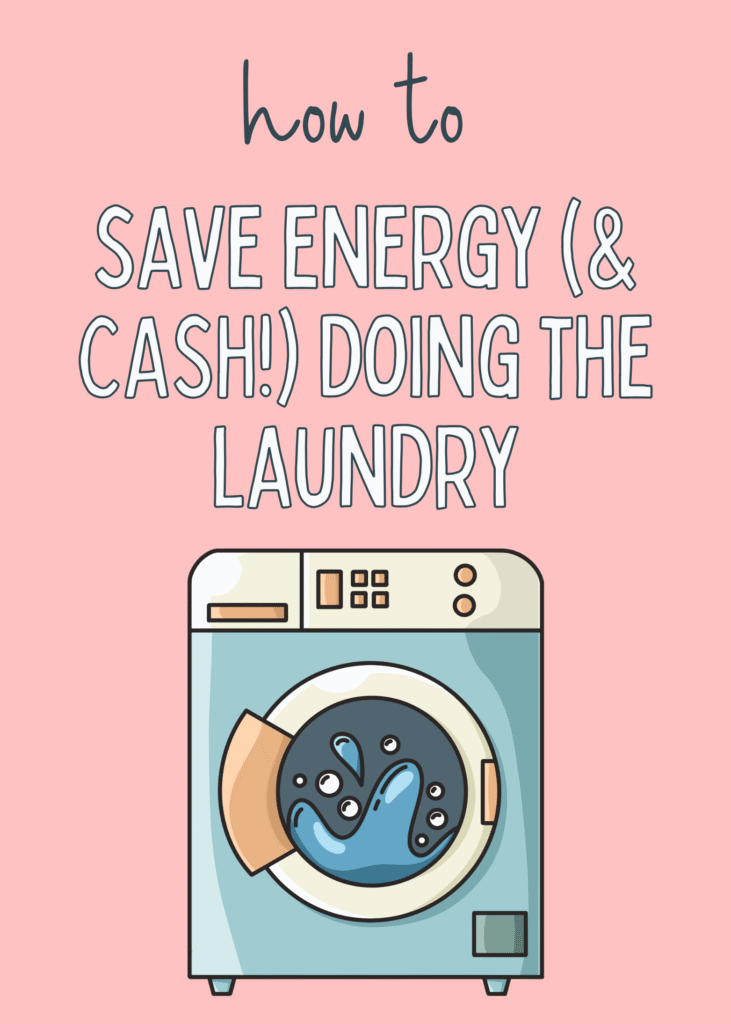* We sometimes use affiliate links, so we may receive a commission, at no cost to you, if you make a purchase through a link. Check our disclosure for more info.
Running the washing machine is a part of daily life. For most UK households, the average machine goes on 3–5 times per week, and with rising energy prices, those washes can add up. The good news? Laundry is one of the easiest household chores to make cheaper and more energy-efficient — without sacrificing clean clothes.

This guide breaks down how to save energy and money in your washes, covering everything from water temperature and spin speeds to load sizes and detergents. We’ll also compare the cost of cold, warm, and hot washes in the UK, and share practical habits that add up to real savings over the year.
Why Laundry Energy Savings Matter
Rising energy costs in the UK
In recent years, energy bills have surged. According to Ofgem, the average household electricity cost sits between 22–30p per kWh (depending on tariff and region). A washing machine typically uses 0.5–2.5 kWh per cycle, depending on temperature and features. That means every wash costs anywhere from 11p to 75p just in electricity. Multiply that by 250–300 cycles per year, and laundry alone can account for £50–£200 annually on your electricity bill.
Environmental impact
Washing at high temperatures and running frequent cycles not only costs money but also increases carbon emissions. Switching to cooler washes and smarter habits can reduce your household carbon footprint significantly.
People Also Asked…
- How to Save Energy (and Money) in Your Washes
- Washing Machine Smells: Causes & Fixes (with Products)
- Brighten Your Whites: The 5 Best Whitening Boosters for Your Washing Machine
- The Best Tumble Dryers For Large Families
- The Best Washing Lines For Small Gardens
How a Washing Machine Uses Energy
To save energy effectively, it helps to understand where it’s spent during a cycle:
- Heating water – the single biggest factor. Heating from 20°C to 60°C can triple the energy use.
- Motor and spinning – relatively efficient compared to heating, though higher spin speeds use slightly more power.
- Pumps and electronics – minor energy draw, usually <10% of total.
- Standby / idle power – small, but over a year, leaving machines on standby can add up.
So, the main energy lever? Water temperature.
Washing Machine Temperature: Cold vs Warm vs Hot Washes
Cold Washes (20–30°C)
- Energy use: ~0.3–0.5 kWh per cycle (costing around 7–15p).
- Best for: lightly soiled clothes, bright colours, delicates.
- Benefits: saves the most energy, protects fabrics and colours, reduces shrinkage.
- Downsides: may not remove heavy stains or kill bacteria fully.
Warm Washes (40°C)
- Energy use: ~0.6–1.0 kWh per cycle (costing around 15–25p).
- Best for: everyday laundry, synthetics, mixed fabrics.
- Benefits: balances cleaning power with energy use.
- Downsides: still uses double the energy of a cold wash.
Hot Washes (60–90°C)
- Energy use: 1.2–2.5 kWh per cycle (costing 30–75p).
- Best for: bedding, towels, underwear, baby clothes, items needing deep hygiene.
- Benefits: kills bacteria, shifts grease and stubborn dirt.
- Downsides: high energy use, can wear out fabrics faster, risks colour fading.
👉 Pro tip: In most households, 70–80% of washes can be done cold or warm. Save hot cycles for hygienic loads only.
Spin Speeds: Balancing Drying and Energy
Higher spin speeds extract more water, meaning clothes dry faster (especially useful if you use a tumble dryer). However, they consume slightly more energy and may wear fabrics.
- 800–1000 rpm – gentle, good for delicates and synthetics.
- 1200–1400 rpm – standard for everyday clothes. Balances drying and fabric care.
- 1600+ rpm – maximum water removal, ideal before tumble drying.
If you air-dry your clothes, spin at 1200–1400 rpm.
If you use a tumble dryer, a faster spin (1600 rpm) can actually save energy overall because the dryer uses much more electricity than the washer.
Load Sizes: Don’t Under- or Over-fill
- Underfilling wastes water and energy, as the machine runs a full cycle for a half load.
- Overfilling prevents clothes from moving freely, reducing cleaning quality and sometimes requiring a second wash.
The hand test
A good rule: fill the drum so there’s a hand’s width of space at the top. That’s the sweet spot for energy efficiency and cleaning.
👉 Pro tip: If your washer has a half-load or eco mode, use it — but note that it doesn’t always cut energy use proportionally.
Choosing Energy-Efficient Detergents
Detergents play a hidden role in energy use:
- Enzyme-based detergents work well at lower temperatures (30°C). They help break down stains without needing heat.
- Non-bio detergents often need warmer washes to activate properly, though they’re gentler on sensitive skin.
- Powder vs liquid: Powders can be slightly better for whites and high-temp washes; liquids dissolve better in cold washes.
👉 If you want to maximise energy savings, switch to detergents designed for cold washes.
Eco and Energy-Saving Modes
Most modern washing machines come with “Eco,” “Quick,” or “Cold Wash” modes. Here’s what they mean:
- Eco mode: Uses less energy but takes longer (lower temperature, extended soak time). Best overall for energy savings.
- Quick wash: Saves time but may use more energy per minute. Good for lightly soiled loads, not for routine use.
- Cold wash: Runs at 20–30°C, minimising heating.
Always check your manual — some eco modes cut electricity by 30–50%.
UK Cost Comparison: Cold vs Hot
Let’s break down the annual savings for a household doing 250 washes per year:
- Cold (30°C average, 0.5 kWh): 125 kWh per year → ~£30
- Warm (40°C average, 0.8 kWh): 200 kWh per year → ~£50
- Hot (60°C average, 1.5 kWh): 375 kWh per year → ~£95
Savings: Switching from mostly hot washes to cold washes can cut laundry electricity use by 60–70%, saving £60+ per year for a typical family.
Additional Energy-Saving Habits
1. Wash full loads only
Every cycle has a baseline energy cost regardless of load size. Fewer, fuller washes = less total energy.
2. Wash less often
Many clothes (jeans, jumpers) don’t need washing after every wear. Air them out and spot-clean when possible.
3. Use off-peak hours
If you’re on an Economy 7 or flexible tariff, run your machine during off-peak times for cheaper rates.
4. Maintain your machine
Clean the filter, drum, and detergent drawer. A clogged washer uses more energy to achieve the same result.
5. Line-dry whenever possible
Tumble dryers use 2–4 kWh per load — far more than a washer. Air-drying in summer can halve your laundry energy footprint.
6. Turn off standby
Unplug or fully switch off your machine between uses. Standby draw is small, but adds up over months.
Fabric Care vs Energy Saving
- Delicates (silk, lace, wool): wash cold with gentle detergents. Energy-friendly already.
- Whites / heavily soiled: occasional 60°C wash with powder. Use sparingly for hygiene, not routine.
- Everyday clothes: 30–40°C with enzyme detergents = balance of clean and efficiency.
- Towels and bedding: mix methods — a hot wash once a month, cold/warm the rest of the time.
Long-Term Savings: The Bigger Picture
Over 10 years of ownership:
- Switching to mostly cold washes could save £600–£800 in electricity.
- Reducing tumble dryer reliance could save another £1,500+.
- Fabrics last longer, meaning fewer replacements and less textile waste.
FAQs
Q: Does washing at 30°C really clean clothes properly?
Yes, for everyday dirt and sweat, modern detergents are designed for 30°C. Just add the occasional hotter wash for hygiene.
Q: Is eco mode worth the longer cycle?
Yes — even though eco takes longer, it heats water less, so it saves electricity overall.
Q: What about handwashing — is it cheaper?
Not necessarily. Heating water in a sink with a kettle may use more energy than a cold machine cycle.
Q: Do laundry balls or magnets save energy?
There’s little scientific evidence they replace detergent or reduce energy use. Stick to proven methods.
Conclusion
Washing smarter doesn’t mean sacrificing clean clothes. By lowering temperatures, choosing the right spin speed, loading efficiently, and using eco-friendly detergents, you can cut your laundry energy use by more than half.
For the average UK household, that’s a saving of £60–£100 per year — plus longer-lasting clothes and a smaller environmental footprint. Combine this with air-drying, smart tariffs, and occasional hot cycles for hygiene, and you’ll strike the perfect balance between cleanliness, cost, and sustainability.
Laundry might always be a chore, but at least it doesn’t need to be an expensive one.
